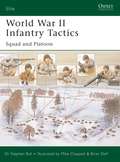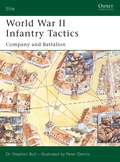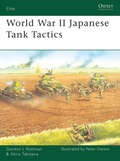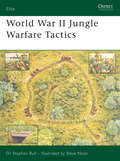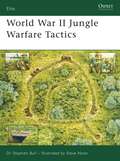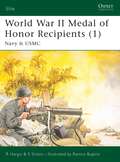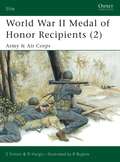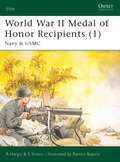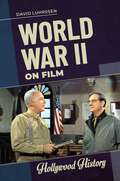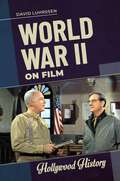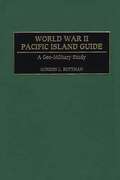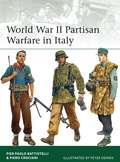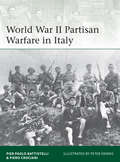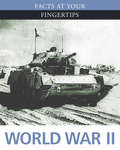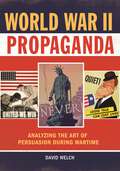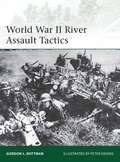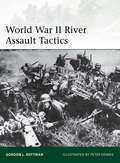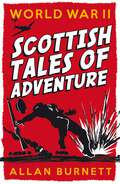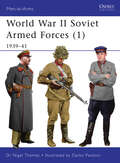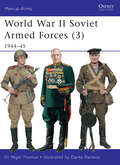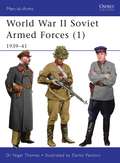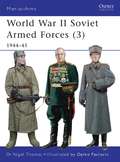- Table View
- List View
World War II Infantry Tactics: Squad and Platoon (Elite)
by Stephen BullDespite all technological advances, final mastery of any battlefield depends upon the tight-knit group of footsoldiers trained to manoeuvre, shoot and dig in. This first of a two-part study examines the methods by which the Western infantry of World War II - the German, British and US armies - actually brought their firepower to bear. Drawing upon period training manuals for the evolving theory, and on personal memoirs for the individual practice, this first book covers the organization and tactics of the squad of ten or a dozen men, and the platoon of three or four squads. The text is illustrated with contemporary photographs and diagrams, and with colour plates bringing to life the movement of soldiers on the battlefield.
World War II Infantry Tactics: Company and Battalion (Elite)
by Stephen BullWorld War II is often seen as a confrontation of technology – tanks and aircraft, artillery and engineering. But at the heart of the battlefield was the struggle between infantrymen, and the technology was there to enable them to capture ground or hold it. This second of two books on the organization and tactics of the German, US and British infantry in Europe focuses on national differences in the development of company and battalion tactics – including those of motorized units – and the confrontation and co-operation between infantry and tanks. Contemporary photos and diagrams and vivid colour plates illustrate what tactical theories actually meant on the ground at human scale.
World War II Infantry Tactics: Squad and Platoon (Elite)
by Stephen BullDespite all technological advances, final mastery of any battlefield depends upon the tight-knit group of footsoldiers trained to manoeuvre, shoot and dig in. This first of a two-part study examines the methods by which the Western infantry of World War II - the German, British and US armies - actually brought their firepower to bear. Drawing upon period training manuals for the evolving theory, and on personal memoirs for the individual practice, this first book covers the organization and tactics of the squad of ten or a dozen men, and the platoon of three or four squads. The text is illustrated with contemporary photographs and diagrams, and with colour plates bringing to life the movement of soldiers on the battlefield.
World War II Japanese Tank Tactics (Elite #169)
by Gordon L. Rottman Akira TakizawaALSO AVAILABLE AS AN E-BOOK. In this book, expert author and tactician Gordon L Rottman provides the first English-language study of Japanese Army and Navy tank units, their tactics and how they were deployed in action. The Japanese army made extensive use of its tanks in the campaigns in China in the 1930s, and it was in these early successes that the Japanese began to develop their own unique style of tank tactics. From the steam-rolling success of the Japanese as they invaded Manchuria until the eventual Japanese defeat, Rottman provides a battle history of the Japanese tank units as they faced the Chinese, the Russians, the British and the Americans.
World War II Jungle Warfare Tactics (Elite #151)
by Mr Steve Noon Dr Stephen BullThis book describes and illustrates, in fascinating detail, the slow and painful learning curve followed by the Allies in the mid-war years as they attempted to end the Japanese stranglehold on Southeast Asia and the Pacific. Based on the actual wartime training documents and front-line memoirs, it shows how the British, Australian and US armies transformed their tactics, attitudes and equipment to master the art of jungle warfare. In 1944-45 the Allies finally conquered the jungle environment, exploiting their new strengths and their enemy's weaknesses, to win crushing victories in Burma and on the Pacific islands.
World War II Jungle Warfare Tactics (Elite)
by Steve Noon Stephen BullThis book describes and illustrates, in fascinating detail, the slow and painful learning curve followed by the Allies in the mid-war years as they attempted to end the Japanese stranglehold on Southeast Asia and the Pacific. Based on the actual wartime training documents and front-line memoirs, it shows how the British, Australian and US armies transformed their tactics, attitudes and equipment to master the art of jungle warfare. In 1944-45 the Allies finally conquered the jungle environment, exploiting their new strengths and their enemy's weaknesses, to win crushing victories in Burma and on the Pacific islands.
World War II Medal of Honor Recipients: Navy & USMC (Elite #92)
by Ramiro Bujeiro Robert Hargis Starr SintonThe Medal of Honor is the highest military award that can be bestowed on personnel in the United States' Armed Forces. This book is the first of two titles looking at the recipients of the Medal of Honor during World War II. It covers Navy and Marine Corps awardees in all theaters of war, from the attack on Pearl Harbor in 1941 to the brutal fighting on Iwo Jima in 1945. Among the inspiring stories told are those of Signalman 1st Class Douglas Munro, the only Coast Guardsman to ever receive the Medal of Honor, and Commander Antrim, who faced almost certain death to save fellow prisoners in a Japanese prisoner of war camp.
World War II Medal of Honor Recipients: Army & Air Corps (Elite)
by Ramiro Bujeiro Robert Hargis Starr SintonThe Medal of Honor is the highest award for valor in action against an enemy force that can be awarded to personnel in the United States' Armed Forces. From the early fighting in the Philippines through the D-Day landings in Northwest Europe to the final assaults in the Pacific, this book looks at the brave US soldiers and airmen who were awarded the Medal of Honor for their actions in the face of danger. It tells the exciting combat stories of such famous figures as the film star Audie Murphy, one of the most decorated US soldier of WWII, alongside less well-known awardees.
World War II Medal of Honor Recipients: Navy & USMC (Elite #92)
by Ramiro Bujeiro Robert Hargis Starr SintonThe Medal of Honor is the highest military award that can be bestowed on personnel in the United States' Armed Forces. This book is the first of two titles looking at the recipients of the Medal of Honor during World War II. It covers Navy and Marine Corps awardees in all theaters of war, from the attack on Pearl Harbor in 1941 to the brutal fighting on Iwo Jima in 1945. Among the inspiring stories told are those of Signalman 1st Class Douglas Munro, the only Coast Guardsman to ever receive the Medal of Honor, and Commander Antrim, who faced almost certain death to save fellow prisoners in a Japanese prisoner of war camp.
World War II Medal of Honor Recipients: Army & Air Corps (Elite #95)
by Ramiro Bujeiro Robert Hargis Starr SintonThe Medal of Honor is the highest award for valor in action against an enemy force that can be awarded to personnel in the United States' Armed Forces. From the early fighting in the Philippines through the D-Day landings in Northwest Europe to the final assaults in the Pacific, this book looks at the brave US soldiers and airmen who were awarded the Medal of Honor for their actions in the face of danger. It tells the exciting combat stories of such famous figures as the film star Audie Murphy, one of the most decorated US soldier of WWII, alongside less well-known awardees.
World War II on Film (Hollywood History)
by David LuhrssenWorld War II on Film examines the war through the lens of 12 films. The movies selected include productions made during World War II and in each succeeding decade, providing a sense of how different generations perceive the war.World War II on Film provides a succinct yet well-grounded appraisal of that war as seen through 12 representative films. The book separates fact from fiction, showing where the movies were accurate and where they departed from reality, and places them in the larger context of historical and social events. Each movie chosen represents a particular aspect of the conflict, including the air war over Europe, the condition of prisoners of war, Nazi atrocities, and the British evacuation at Dunkirk. Unlike most histories of Hollywood during World War II or the genre of war movies, World War II on Film examines in depth the relation between the depictions of events, beliefs, attitudes, and ways of life as seen on film with reality as documented by historians or recorded by journalists or eye-witnesses to the war. The volume will appeal to high school and college readers, as well as general interest readers and film buffs.
World War II on Film (Hollywood History)
by David LuhrssenWorld War II on Film examines the war through the lens of 12 films. The movies selected include productions made during World War II and in each succeeding decade, providing a sense of how different generations perceive the war.World War II on Film provides a succinct yet well-grounded appraisal of that war as seen through 12 representative films. The book separates fact from fiction, showing where the movies were accurate and where they departed from reality, and places them in the larger context of historical and social events. Each movie chosen represents a particular aspect of the conflict, including the air war over Europe, the condition of prisoners of war, Nazi atrocities, and the British evacuation at Dunkirk. Unlike most histories of Hollywood during World War II or the genre of war movies, World War II on Film examines in depth the relation between the depictions of events, beliefs, attitudes, and ways of life as seen on film with reality as documented by historians or recorded by journalists or eye-witnesses to the war. The volume will appeal to high school and college readers, as well as general interest readers and film buffs.
World War II Pacific Island Guide: A Geo-Military Study
by Gordon RottmanCovering all Pacific islands involved in World War II military operations, this book is a detailed, single source of information on virtually every geo-military aspect of the Pacific Theater. Arranged regionally and, to the extent possible, chronologically according to when islands entered the war, entries provide complete background information. Along with island names, nicknames, Allied code names, location, and wartime time zones, the entries include such topics as the island's physical characteristics, weather, health hazards, historical background, native population, natural resources, and military value. Japanese and Allied strategies and operations, military problems caused by terrain, military installations, Japanese units and key commanders, Allied units and key commanders, and brief battle descriptions are also covered along with the island's postwar status.A valuable resource for researchers, historians, military history enthusiasts, and war gamers, the book provides complete background information on the geo-military aspects of the Pacific Ocean region, its islands, and the roles they played in the war. 108 maps provide specific information. Until now, geo-military information could only be found by searching four to ten publications on each island.
World War II Partisan Warfare in Italy (Elite)
by Peter Dennis Pier Paolo Battistelli Piero CrocianiWhen Italy surrendered in 1943, it sparked a resistance movement of anti-German, anti-fascist partisans. This book explores the tactics, organizational structure and equipment of the brave Italian resistance fighters. Beginning with low-level sabotage and assassinations, the groups continued to grow until spring 1944 when a remarkable, unified partisan command structure was created. Working in close co-ordination with the Allies, they received British SOE and American OSS liaison teams as well as supplies of weapons. The German response was ferocious, and in autumn 1944, as the Allied advance stalled, the SS and Italian RSI looked to eradicate the partisans once and for all. But when the Allies made their final breakthrough in the last weeks of the war the partisans rose again to exact their revenge on the retreating Wehrmacht. From an expert on Italian military history in World War II, this work provides a comprehensive guide to the men and women who fought a desperate struggle against occupation, as well as the German and Italian fascist security forces unleashed against them.
World War II Partisan Warfare in Italy (Elite)
by Peter Dennis Pier Paolo Battistelli Piero CrocianiWhen Italy surrendered in 1943, it sparked a resistance movement of anti-German, anti-fascist partisans. This book explores the tactics, organizational structure and equipment of the brave Italian resistance fighters. Beginning with low-level sabotage and assassinations, the groups continued to grow until spring 1944 when a remarkable, unified partisan command structure was created. Working in close co-ordination with the Allies, they received British SOE and American OSS liaison teams as well as supplies of weapons. The German response was ferocious, and in autumn 1944, as the Allied advance stalled, the SS and Italian RSI looked to eradicate the partisans once and for all. But when the Allies made their final breakthrough in the last weeks of the war the partisans rose again to exact their revenge on the retreating Wehrmacht. From an expert on Italian military history in World War II, this work provides a comprehensive guide to the men and women who fought a desperate struggle against occupation, as well as the German and Italian fascist security forces unleashed against them.
World War II: Day By Day (Facts at Your Fingertips: Military History #2)
by Antony ShawThis book on World War II examines in detail the conflict that was fought across the globe between 1939 and 1945. For each battle featured, such as Kursk, Stalingrad and Midway, there is a description of the events, casualty figures and key actions, with maps throughout. This book presents all the facts of a war that remains within living memory.
World War II Propaganda: Analyzing the Art of Persuasion during Wartime
by David WelchShows in illuminating detail how the Allied and Axis forces used visual images and other propaganda material to sway public opinion during World War II.Author David Welch provides a neatly organized primary resource that focuses on key themes associated with World War II propaganda. Readers will not only be engrossed with a wide range of propaganda artifacts, they will also receive a better and more nuanced understanding of the nature of this propaganda and how it was disseminated in different cultural and political contexts. This book reveals how leaders and spin doctors operating at behest of the state sought to shape popular attitudes both at home and overseas. A comprehensive introductory essay sets out the principles of propaganda theory in World War II, while the subsequent material provides examples of Allied- and Axis-generated propaganda and presents them in a readily accessible way that will help readers understand the context.
World War II Propaganda: Analyzing the Art of Persuasion during Wartime
by David WelchShows in illuminating detail how the Allied and Axis forces used visual images and other propaganda material to sway public opinion during World War II.Author David Welch provides a neatly organized primary resource that focuses on key themes associated with World War II propaganda. Readers will not only be engrossed with a wide range of propaganda artifacts, they will also receive a better and more nuanced understanding of the nature of this propaganda and how it was disseminated in different cultural and political contexts. This book reveals how leaders and spin doctors operating at behest of the state sought to shape popular attitudes both at home and overseas. A comprehensive introductory essay sets out the principles of propaganda theory in World War II, while the subsequent material provides examples of Allied- and Axis-generated propaganda and presents them in a readily accessible way that will help readers understand the context.
World War II River Assault Tactics (Elite #195)
by Peter Dennis Gordon L. RottmanOn the major European and Russian fronts throughout World War II, the challenge of crossing rivers under fire was absolutely central to any advance. The Panzers that crossed the Meuse at Sedan in May 1940 cut the French Army in two. The Wehrmacht's ability to cross the great rivers of the western USSR was vital to the lightning advances of Operation Barbarossa in 1941, and in 1943–45 the Red Army had to drive the Germans back from a succession of river lines during their advance to the Reich, culminating in the Vistula and Oder lines. With World War II armies dependent on heavy mechanized equipment, the function which rivers played became essential for soldiers in all sides of the war. World War II River Assault Tactics details the methods, means and analysis of specific successes and failures. Featuring a wealth of wartime photos, particularly from German sources, and full-colour plates illustrating tactical scenarios, the subject is brought to life.
World War II River Assault Tactics (Elite #195)
by Peter Dennis Gordon L. RottmanOn the major European and Russian fronts throughout World War II, the challenge of crossing rivers under fire was absolutely central to any advance. The Panzers that crossed the Meuse at Sedan in May 1940 cut the French Army in two. The Wehrmacht's ability to cross the great rivers of the western USSR was vital to the lightning advances of Operation Barbarossa in 1941, and in 1943–45 the Red Army had to drive the Germans back from a succession of river lines during their advance to the Reich, culminating in the Vistula and Oder lines. With World War II armies dependent on heavy mechanized equipment, the function which rivers played became essential for soldiers in all sides of the war. World War II River Assault Tactics details the methods, means and analysis of specific successes and failures. Featuring a wealth of wartime photos, particularly from German sources, and full-colour plates illustrating tactical scenarios, the subject is brought to life.
World War II: Scottish Tales of Adventure
by Allan BurnettAcclaimed children's author Allan Burnett turns his attention to the Second World War in a book of explosively exciting and emotionally charged tales of bravery and adventure. Featuring the true exploits of soldiers, spies, pilots, sailors and many others, these stories, all based on interviews with these heroes themselves or their descendants, offer a unique, personal insight into the Second World War that no conventional history book can ever hope to match.
World War II Soviet Armed Forces: 1939–41 (Men-at-Arms #464)
by Nigel ThomasThis book is a detailed analysis of the Soviet Army at the outbreak of World War II, including the Red Army's campaigns against Japan on the Manchurian plains as well as in Finland. It covers the Red Army's first operations during Operation Barbarossa when the Red Army was forced to defend Mother Russia against the German onslaught. It offers a breakdown of all the armed forces including the army, air force, paratroopers, navy and NKVD troops. In particular it covers the evolution of uniforms, equipment and insignia with the introduction of new regulations in 1935 and 1940.
World War II Soviet Armed Forces: 1944–45 (Men-at-Arms #469)
by Nigel ThomasThis book presents a detailed analysis of the Soviet armed forces during the final days of the war, covering the soldiers that successfully turned the tide against the Nazi onslaught and pushed it back into Germany itself. This final part of the series documents the Red Army's push through Germany to Berlin, which eventually culminated in the surrender of the German forces to the Allies in 1945. It also offers a detailed breakdown of all the armed forces that conducted the offensive campaigns on the Eastern Front, including the army, air force, paratroopers, navy and NKVD troops. Its colourful illustrations also include the uniforms and organizations of the Russian forces serving against Japan until the eventual surrender of all Japanese Imperial forces in August 1945.
World War II Soviet Armed Forces: 1939–41 (Men-at-Arms)
by Nigel Thomas Darko PavlovicThis book is a detailed analysis of the Soviet Army at the outbreak of World War II, including the Red Army's campaigns against Japan on the Manchurian plains as well as in Finland. It covers the Red Army's first operations during Operation Barbarossa when the Red Army was forced to defend Mother Russia against the German onslaught. It offers a breakdown of all the armed forces including the army, air force, paratroopers, navy and NKVD troops. In particular it covers the evolution of uniforms, equipment and insignia with the introduction of new regulations in 1935 and 1940.
World War II Soviet Armed Forces: 1944–45 (Men-at-Arms)
by Nigel Thomas Darko PavlovicThis book presents a detailed analysis of the Soviet armed forces during the final days of the war, covering the soldiers that successfully turned the tide against the Nazi onslaught and pushed it back into Germany itself. This final part of the series documents the Red Army's push through Germany to Berlin, which eventually culminated in the surrender of the German forces to the Allies in 1945. It also offers a detailed breakdown of all the armed forces that conducted the offensive campaigns on the Eastern Front, including the army, air force, paratroopers, navy and NKVD troops. Its colourful illustrations also include the uniforms and organizations of the Russian forces serving against Japan until the eventual surrender of all Japanese Imperial forces in August 1945.
